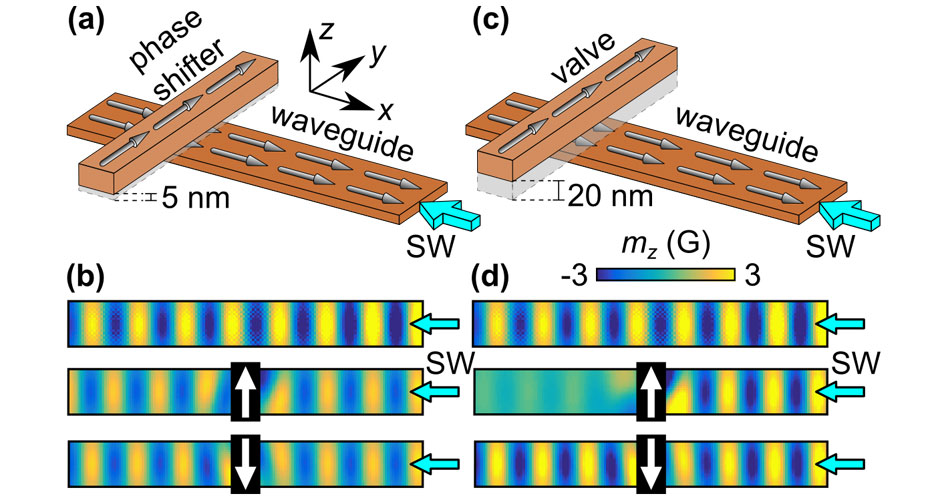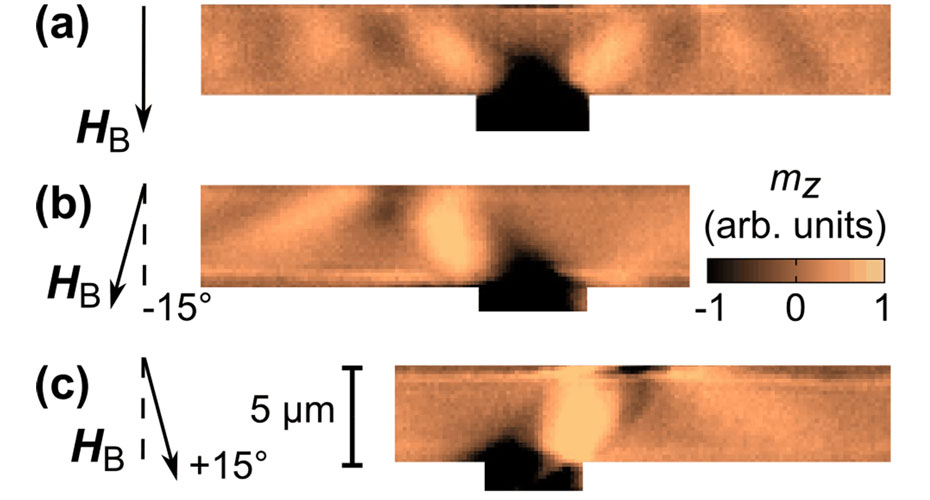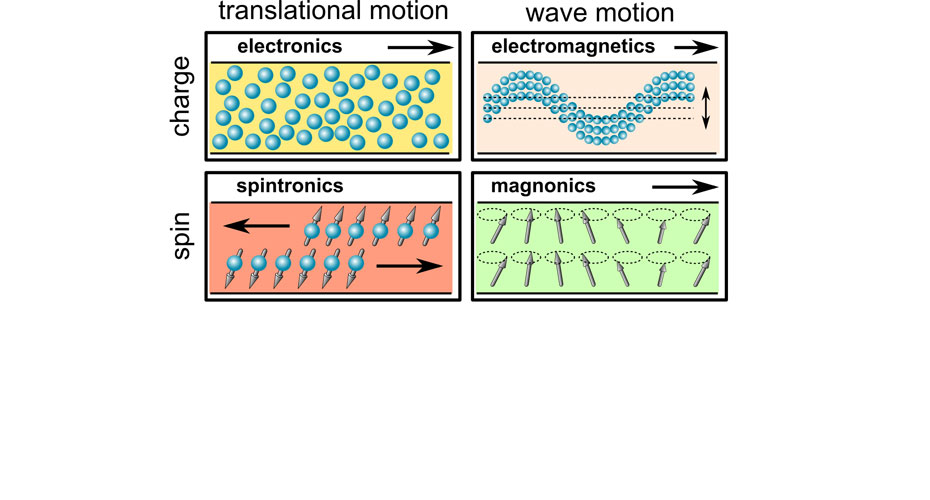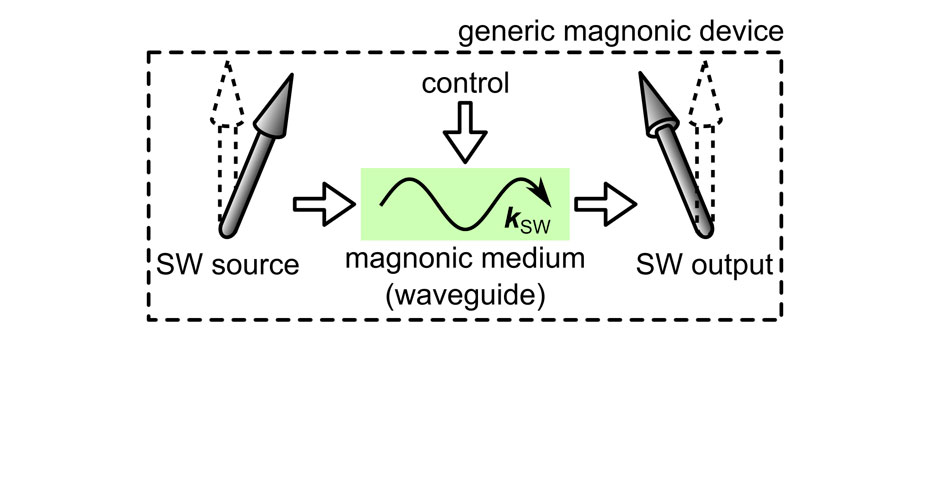
(a) The Fano control element is positioned 5 nm above the waveguide. A spin wave (SW) excited elsewhere propagates along the waveguide in the negative x direction. (b) The first (top) snapshot shows the out-of-plane component of magnetisation (mz) when the control element is absent. The second (middle) and third (bottom) snapshots show mz with the control element present and magnetized parallel and antiparallel to the y-axis, respectively. (c)-(d) The same as (a)-(b) but for the control element positioned 20 nm above the waveguide.
After C. S. Davies, Y. Au, and V. V. Kruglyak, “Prototype magnonic device development”, p. 54 in “Magnetics Technology International” (UKIP Media, Surrey, 2015).

Experimental snapshots of spin waves propagating in a magnonic demultiplexer.
The spin wave is split equally when the external magnetic field HB is applied symmetrically (panel (a)) but is steered left (panel (b)) and right (panel (c)) when the field is tilted by angles of -15° and +15°, respectively.
After: C. S. Davies, et al, “Towards graded-index magnonics: Steering spin waves in magnonic networks”, Phys. Rev. B 92, 020408 (2015).
Magnonics
Magnonics studies phenomena associated with spin waves – elementary excitations of the magnetic order in magnetic materials – and their quanta – magnons [1].
Spin waves (magnons) carry energy and angular momentum via a collective wave (rather than translational) motion of spins. So, the relation between magnonics and spintronics is similar to that between AC and DC electricity.
People
This sub-theme is led by Professor Volodymyr Kruglyak, working alongside Professor Rob Hicken, Dr Andrey Shytov, Dr Tom Philbin, Dr Simon Horsley, Professor Feodor Ogrin and Dr Jacopo Bertolotti.
Applications of magnonics
Magnonics allows technology that would use spin waves (or magnons) to carry and process both analog signals and digital data. The most attractive feature of this so called “magnonic technology” is that the spectrum of magnons and therefore dynamic properties of magnonic devices can be easily reconfigured and tuned by an external magnetic field or spin-polarised currents.
Moreover, for most practically relevant situations, the wavelength of magnons is orders of magnitude shorter than that of photons of the same frequency. So, the size of magnonic devices can be more easily reduced to the nanoscale.
Current research
In Exeter, we investigate magnonic phenomena in continuous and patterned magnetic structures, magnonic crystals and metamaterials, and magnonic devices. The focus of our current research is on:
- methods of excitation of spin waves with ultrashort (nanoscale) wavelengths, including via so called Schlömann [2] and Fano [3] mechanisms, using a microwave magnetic field [2,3] and spin torques [4];
- spin wave propagation and manipulation in continuous and structured (including magnonic crystals [5] and metamaterials [6]) media with a graded magnonic index [7];
- coupled excitations in magneto-elastic and magnon-superconductor media, metamaterials and devices;
- ultrafast studies of spin waves in antiferromagnets and other multi-sublattice magnets, structures and devices at THz frequencies [8];
- magnonics theory.
- V. V. Kruglyak, S. O. Demokritov and D. Grundler, “Magnonics”, J. Phys. D: Appl. Phys. 43, 264001 (2010).
- F. B. Mushenok, R. Dost, C. S. Davies, D. A. Allwood, B. Inkson, G. Hrkac and V. V. Kruglyak, “Broadband conversion of microwaves into propagating spin waves in patterned magnetic structures”, Appl. Phys. Lett. 111, 042404 (2017).
- Y. Au, E. Ahmad, O. Dmytriiev, M. Dvornik, T. Davison, and V. V. Kruglyak, “Resonant microwave-to-spin-wave transducer”, Appl. Phys. Lett. 100, 182404 (2012).
- P. S. Keatley, S. R. Sani, G. Hrkac, S. M. Mohseni, P. Durrenfeld, T. H. J. Loughran, J. Akerman, and R. J. Hicken, “Direct observation of magnetization dynamics generated by nanocontact spin-torque vortex oscillators”, Phys. Rev. B 94, 060402 (2016).
- V. V. Kruglyak, C. S. Davies, V. S. Tkachenko, O. Y. Gorobets, Y. I. Gorobets, and A. N. Kuchko, “Formation of the band spectrum of spin waves in 1D magnonic crystals with different types of interfacial boundary conditions”, J. Phys. D – Appl. Phys. 50, 094003 (2017).
- R. V. Mikhaylovskiy, E. Hendry, and V. V. Kruglyak, “Negative permeability due to exchange spin-wave resonances in thin magnetic films with surface pinning”, Phys. Rev. B 82, 195446 (2010).
- C. S. Davies and V. V. Kruglyak, “Graded-index magnonics”, Low Temp. Phys. 41, 760 (2015).
- R. V. Mikhaylovskiy, et al, “Ultrafast optical modification of exchange interactions in iron oxides”, Nature Commun. 6, 8190 (2015).


